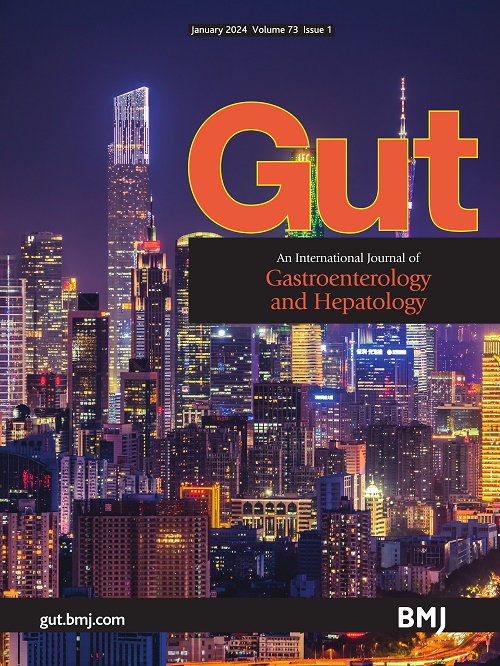肠道微生物调节3-羟基苯甲酸和多巴胺能信号影响肥胖患者的注意力
IF 25.8
1区 医学
Q1 GASTROENTEROLOGY & HEPATOLOGY
引用次数: 0
摘要
肠道菌群中与肥胖相关的改变与认知能力下降有关,但它们与注意力的关系尚不清楚。目的探讨肠道宏基因组学、血浆代谢组学与注意力的可能关系。我们在三个独立的队列(n=156, n=124, n=804)中进行了粪便鸟枪宏基因组学和靶向血浆色氨酸代谢组学,并在临床前模型中进行了功能验证,包括小鼠和黑胃果蝇的三个粪便微生物群移植(FMT)实验。结果肥胖始终与注意力下降有关。宏基因组学分析发现,与色氨酸生物合成有关的变形菌种类和微生物功能与肥胖的注意力呈负相关。血浆色氨酸代谢分析和机器学习显示,3-羟基苯甲酸(3-HAA)与注意力呈正相关,尤其是在肥胖中,而AA呈负相关。减肥手术改善了注意力,并丰富了与注意力相关的微生物种类。在小鼠中,饮食性肥胖(DIO)和微生物群消耗降低了前额皮质(PFC)中3-HAA和5-羟基吲哚乙酸(5-HIAA)的浓度,这些浓度通过FMT恢复。FMT组PFC的全球代谢分析(bbb600个代谢物)发现,在接受高度关注供体微生物群的小鼠中,3-HAA、色氨酸和酪氨酸途径最为显著。第二次FMT实验还发现,在转录水平上,PFC中色氨酸和酪氨酸代谢一致富集,其中3-羟基苯基酸双加氧酶Haao和醛氧化酶Aox4是3-HAA和5-HIAA降解的关键基因。在第三项FMT研究中,注意力特征与血清素能和多巴胺能通路的调节一起从人类传递给小鼠。在果蝇中,阴沟肠杆菌和DIO的单定殖诱导了类似注意缺陷的行为,这可以通过补充3-HAA来缓解。结论:我们已经确定了微生物群和3-HAA作为潜在的治疗靶点,以提高注意力,特别是肥胖。如有合理要求,可提供资料。不适用。本文章由计算机程序翻译,如有差异,请以英文原文为准。
Gut microbial modulation of 3-hydroxyanthranilic acid and dopaminergic signalling influences attention in obesity
Background Obesity-related alterations in the gut microbiota have been linked to cognitive decline, yet their relationship with attention remains poorly understood. Objective To evaluate the possible relationships among gut metagenomics, plasma metabolomics and attention. Design We conducted faecal shotgun metagenomics and targeted plasma tryptophan metabolomics across three independent cohorts (n=156, n=124, n=804) with functional validations in preclinical models, including three faecal microbiota transplantation (FMT) experiments in mice and Drosophila melanogaster . Results Obesity was consistently associated with reduced attention. Metagenomics analyses identified Proteobacteria species and microbial functions related to tryptophan biosynthesis from anthranilic acid (AA) as negatively associated with attention in obesity. Plasma tryptophan metabolic profiling and machine learning revealed that 3-hydroxyanthranilic acid (3-HAA) was positively associated with attention, particularly in obesity, while AA showed a negative association. Bariatric surgery improved attention and enriched microbial species linked to attention. In mice, diet-induced obesity (DIO) and microbiota depletion reduced 3-HAA and 5-hydroxy-indole acetic acid (5-HIAA) concentrations in the prefrontal cortex (PFC), which were restored by FMT. Global metabolic profiling (>600 metabolites) of PFC from the FMT group identified 3-HAA and the tryptophan and tyrosine pathways among the most significant in mice receiving microbiota from high-attention donors. A second FMT experiment also revealed a consistent enrichment of the tryptophan and tyrosine metabolism at the transcriptional level in the PFC, with Haao (3-hydroxyantrhanilic acid dioxygenase) and Aox4 (aldehyde oxidase 4), key in 3-HAA and 5-HIAA degradation, among the significantly regulated genes. In a third FMT study, attentional traits were transmitted from humans to mice alongside modulation of serotonergic and dopaminergic pathways. In Drosophila , mono-colonisation with Enterobacter cloacae and DIO induced attention deficit-like behaviours, which were mitigated by 3-HAA supplementation. Conclusions We have identified the microbiota and 3-HAA as potential therapeutic targets to improve attention, especially in obesity. Data are available upon reasonable request. Not applicable.
求助全文
通过发布文献求助,成功后即可免费获取论文全文。
去求助
来源期刊

Gut
医学-胃肠肝病学
CiteScore
45.70
自引率
2.40%
发文量
284
审稿时长
1.5 months
期刊介绍:
Gut is a renowned international journal specializing in gastroenterology and hepatology, known for its high-quality clinical research covering the alimentary tract, liver, biliary tree, and pancreas. It offers authoritative and current coverage across all aspects of gastroenterology and hepatology, featuring articles on emerging disease mechanisms and innovative diagnostic and therapeutic approaches authored by leading experts.
As the flagship journal of BMJ's gastroenterology portfolio, Gut is accompanied by two companion journals: Frontline Gastroenterology, focusing on education and practice-oriented papers, and BMJ Open Gastroenterology for open access original research.
 求助内容:
求助内容: 应助结果提醒方式:
应助结果提醒方式:


